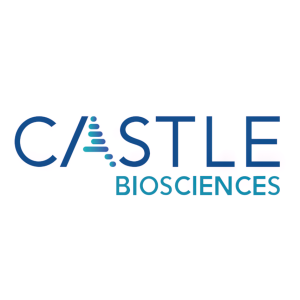New Data at ASCO 2025 Affirms DecisionDx®-Melanoma's Ability to Improve Upon Staging-Based Risk Stratification and Predict Survival Outcomes
Rhea-AI Summary
Positive
- DecisionDx-Melanoma test demonstrated 32% reduction in mortality risk vs untested patients
- Largest real-world study of gene expression profile testing to date (13,560 patients)
- Test proved significant predictor of melanoma-specific mortality with strong hazard ratios
- New uveal melanoma test showed high sensitivity (91%) and negative predictive value (92%)
Negative
- None.
Insights
Castle's DecisionDx-Melanoma test demonstrates 32% mortality reduction in largest real-world study, significantly improving melanoma risk assessment beyond conventional staging.
The data from Castle Biosciences' ASCO 2025 presentation represents a significant advancement in precision oncology for melanoma management. The expanded validation study involving over 13,500 patients demonstrates that the DecisionDx-Melanoma test provides superior risk stratification compared to conventional AJCC staging alone. Most impressively, patients who received the test showed a
The multivariate analysis reveals the test's robust predictive power, with Class 2B results showing a hazard ratio of 4.59 and Class 1B/2A results showing a hazard ratio of 3.42 for melanoma-specific mortality. These values remained significant even after controlling for established risk factors including Breslow thickness, ulceration, nodal status, age, and mitotic rate.
This genomic approach addresses a critical limitation in current melanoma management: conventional staging provides population-level risk assessments but fails to account for tumor biology unique to each patient. By incorporating the 31-gene expression profile, clinicians can now make more informed decisions about sentinel lymph node biopsy referrals and surveillance intensity based on individualized biological risk rather than population averages.
The secondary presentation on uveal melanoma also demonstrates innovation in liquid biopsy approaches for rare but aggressive eye cancers, potentially enabling earlier intervention through less invasive monitoring of suspicious lesions.
These findings further solidify the clinical utility of gene expression profiling in melanoma management and suggest that incorporating such testing into standard clinical pathways could significantly improve patient outcomes through more precise risk-aligned treatment decisions.
Study results show that DecisionDx-Melanoma was associated with a
FRIENDSWOOD, Texas, May 29, 2025 (GLOBE NEWSWIRE) -- Castle Biosciences, Inc. (Nasdaq: CSTL), a company improving health through innovative tests that guide patient care, will present novel research aimed at enhancing the clinical management of patients with cutaneous melanoma (CM) and uveal melanoma (UM) at the 2025 American Society of Clinical Oncology (ASCO) Annual Meeting, being held May 30-June 3, 2025, in Chicago. This includes the latest findings from Castle's ongoing collaboration with the National Cancer Institute's Surveillance, Epidemiology and End Results (NCI's SEER) Program Registries affirming the significant, independent risk stratification provided by DecisionDx-Melanoma in an expanded, real-world cohort of more than 13,500 patients who received the test as part of their melanoma care.
"Management decisions for melanoma patients, such as referrals for sentinel lymph node biopsy and surveillance intensity, are guided by a patient's risk of dying from their disease,” said Merve Hasanov, M.D., oncologist and director of the division of medical oncology at The Ohio State University Comprehensive Cancer Center in Columbus, Ohio. “The findings being presented at ASCO demonstrate that the DecisionDx-Melanoma test can provide more precise mortality risk predictions based on a patient's unique tumor biology and can improve upon the population-based risk assessment provided by American Joint Committee on Cancer (AJCC) staging. This can, in turn, help clinicians tailor treatment approaches to individual patient needs.”
Castle’s presentations at ASCO will take place during the Melanoma/Skin Cancers poster session on Sunday, June 1, from 9 a.m. to 12 p.m. Central time in Hall A – Posters and Exhibits.
- Title: The 31-gene expression profile can guide better risk-aligned care decisions for patients with stage I–III cutaneous melanoma: an NCI-SEER analysis
- Abstract: 9573
- Poster Bd #: 56
- Lead Author: Merve Hasanov, M.D., oncologist and director of the division of medical oncology at The Ohio State University Comprehensive Cancer Center, Columbus, Ohio
- Study highlights: This study presents an updated validation of the DecisionDx-Melanoma test's ability to independently stratify CM patients' mortality risk within AJCC sub-stages (stages I-IIA, IIB-C and III) as part of Castle's ongoing collaboration with the NCI’s SEER Program Registries. In this large, real-world cohort of 13,560 patients with CM – the largest real-world study of gene expression profile testing to date – the test provided significant risk stratification within the AJCC sub-groups (p<0.001). In multivariable analysis that included key AJCC staging criteria (i.e., Breslow thickness, ulceration and nodal status) and other commonly used clinicopathologic risk factors (e.g., age and mitotic rate), DecisionDx-Melanoma test results emerged as a significant predictor of melanoma-specific mortality (Class 2B hazard ratio=4.59, p<0.001; Class 1B/2A hazard ratio=3.42, p<0.001). Further, testing with DecisionDx-Melanoma was associated with a
32% reduction in mortality risk compared to untested patients, providing further evidence of the test’s association with improved patient survival and affirming the test’s potential to inform risk-aligned treatment pathway decisions that may lead to improved patient outcomes.1 - Title: Independent validation of a 16-protein test to assess malignant potential of small uveal melanocytic tumors
- Abstract: 9590
- Poster Bd #: 73
- Lead Author and Presenter: David Alan Reichstein, M.D., retina specialist and ocular oncologist at Tennessee Retina, Nashville, Tennessee
- Study highlights: UM is a rare but aggressive eye cancer with up to
50% of patients developing metastatic disease. While tumor biopsy-based molecular testing (i.e., DecisionDx-UM) is widely utilized to identify high-risk biology, repeated intraocular tumor biopsies are not feasible for monitoring small uveal melanocytic tumors of indeterminate malignant potential (UMTIMP). This multicenter study explored a novel diagnostic approach designed to analyze protein biomarkers in aqueous humor (AH) obtained through minimally invasive, in-office liquid biopsy of the anterior chamber of the eye. In the independent validation, the 17-biomarker test that evaluates 16 proteins and tumor diameter information successfully distinguished between low- and high-risk UM lesions with a sensitivity of91% , specificity of50% , negative predictive value of92% and positive predictive value of47% . If developed, this high-sensitivity test could help to accurately identify high-risk melanocytic lesions that would merit more invasive intraocular biopsy and further prognostic testing with DecisionDx-UM, -PRAME and -UMSeq. The study findings support a liquid biopsy approach to monitor suspicious UMTIMPs for malignant transformation to inform more timely decision-making and earlier therapeutic interventions to help improve patient outcomes.
The full abstracts outlined above can be found at the ASCO website here. For more information regarding Castle’s data at ASCO, please visit booth # 24149.
About DecisionDx-Melanoma
DecisionDx-Melanoma is a 31-gene expression profile risk stratification test. It is designed to inform two clinical questions in the management of cutaneous melanoma: a patient’s individual risk of sentinel lymph node (SLN) positivity and a patient's personal risk of melanoma recurrence and/or metastasis. By integrating tumor biology with clinical and pathologic factors using a validated proprietary algorithm, DecisionDx-Melanoma is designed to provide a comprehensive and clinically actionable result to guide risk-aligned patient care. DecisionDx-Melanoma has been shown to be associated with improved patient survival and has been studied in more than 10,000 patient samples. DecisionDx-Melanoma’s clinical value is supported by more than 50 peer-reviewed and published studies, providing confidence in disease management plans that incorporate the test’s results. Through March 31, 2025, DecisionDx-Melanoma has been ordered more than 200,000 times for patients diagnosed with cutaneous melanoma.
About DecisionDx-UM
DecisionDx-UM is Castle Biosciences’ 15-gene expression profile (GEP) test that uses an individual patient’s tumor biology to predict individual risk of metastasis in patients with uveal melanoma (UM). DecisionDx-UM is the standard of care in the management of newly diagnosed UM in the majority of ocular oncology practices in the United States. Since 2009, the American Joint Committee on Cancer (AJCC; v7 and v8) Staging Manual for UM has specifically identified the GEP test as a prognostic factor that is recommended for collection as a part of clinical care. Further, the National Comprehensive Cancer Network (NCCN) guidelines for UM include the DecisionDx-UM test result as a prognostic method for determining risk of metastasis and recommended differential surveillance regimens based on a Class 1A, 1B and 2 result. DecisionDx-UM is currently the only prognostic test for UM that has been validated in prospective, multi-center studies, and it has been shown to be a superior predictor of metastasis compared to other prognostic factors, such as chromosome 3 status, mutational status, AJCC stage and cell type. It is estimated that nearly 8 in 10 patients diagnosed with UM in the United States receive the DecisionDx-UM test as part of their diagnostic workup.
About Castle Biosciences
Castle Biosciences (Nasdaq: CSTL) is a leading diagnostics company improving health through innovative tests that guide patient care. The Company aims to transform disease management by keeping people first: patients, clinicians, employees and investors.
Castle’s current portfolio consists of tests for skin cancers, Barrett’s esophagus and uveal melanoma. Additionally, the Company has active research and development programs for tests in these and other diseases with high clinical need, including its test in development to help guide systemic therapy selection for patients with moderate-to-severe atopic dermatitis seeking biologic treatment. To learn more, please visit www.CastleBiosciences.com and connect with us on LinkedIn, Facebook, X and Instagram.
DecisionDx-Melanoma, DecisionDx-CMSeq, i31-SLNB, i31-ROR, DecisionDx-SCC, MyPath Melanoma, TissueCypher, DecisionDx-UM, DecisionDx-PRAME and DecisionDx-UMSeq are trademarks of Castle Biosciences, Inc.
Forward-Looking Statements
This press release contains forward-looking statements within the meaning of Section 27A of the Securities Act of 1933, as amended, and Section 21E of the Securities Exchange Act of 1934, as amended, which are subject to the “safe harbor” created by those sections. These forward-looking statements include, but are not limited to, statements concerning: the significant, independent risk stratification provided by DecisionDx-Melanoma; DecisionDx-Melanoma’s ability to (i) provide more precise mortality risk predictions and improve upon population-based risk assessment provide by AJCC staging, (ii) be a significant predictor of melanoma-specific mortality and (iii) improve patient survival and lead to improved patient outcomes; and DecisionDx-UM’s ability to help accurately identify high-risk melanocytic lesions and improve patient outcomes. The words “believe,” “can” and similar expressions are intended to identify forward-looking statements, although not all forward-looking statements contain these identifying words. We may not actually achieve the plans, intentions or expectations disclosed in our forward-looking statements, and you should not place undue reliance on our forward-looking statements. Actual results or events could differ materially from the plans, intentions and expectations disclosed in the forward-looking statements that we make. These forward-looking statements involve risks and uncertainties that could cause our actual results to differ materially from those in the forward-looking statements, including, without limitation: subsequent study or trial results and findings may contradict earlier study or trial results and findings or may not support the results obtained in these studies, including with respect to the discussion of our tests in this press release; actual application of our tests may not provide the aforementioned benefits to patients; and the risks set forth under the heading “Risk Factors” in our Annual Report on Form 10-K for the year ended December 31, 2024, our Quarterly Report for the three months ended March 31, 2025 and in our other filings with the SEC. The forward-looking statements are applicable only as of the date on which they are made, and we do not assume any obligation to update any forward-looking statements, except as may be required by law.
- Bailey CN, Martin BJ, Petkov VI, et al. 31-Gene Expression Profile Testing in Cutaneous Melanoma and Survival Outcomes in a Population-Based Analysis: A SEER Collaboration. JCO Precis. Oncol. 2023; 7. doi: 10.1200/PO.23.00044
Investor Contact:
Camilla Zuckero
czuckero@castlebiosciences.com
Media Contact:
Allison Marshall
amarshall@castlebiosciences.com








